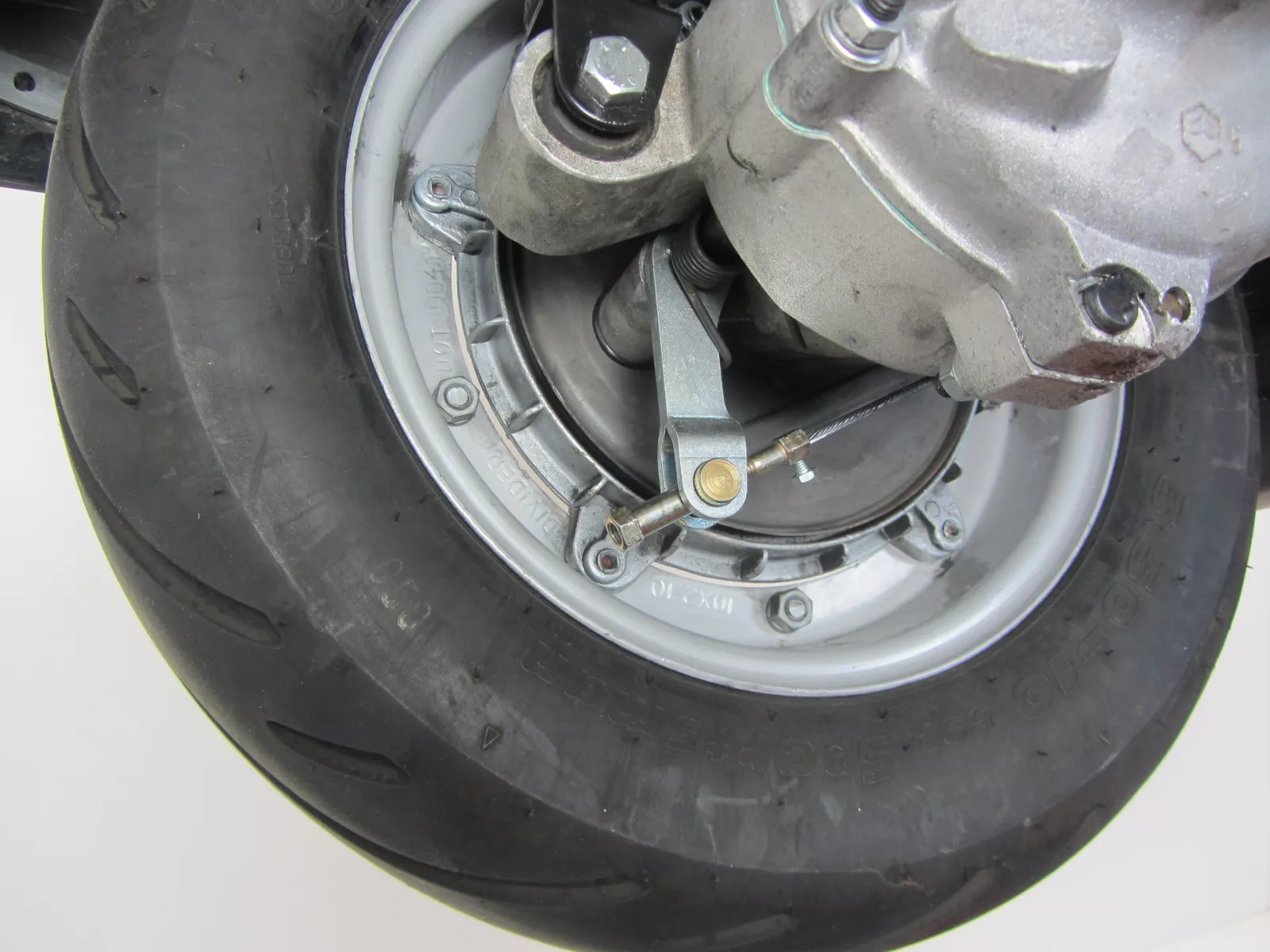Conversion to Adjustable Brake Cable Vespa PX, Rally, Sprint,
The brake pad wear of the front brake on the PX series until 1998 and the PK-XL can be easily adjusted without tools using the known knurled screw on the brake cable. On the Vespa PX125T5, this luxury is even found on the rear brake. On this model, Piaggio already recognized that the fiddly adjustment screw in a hard-to-reach location was no longer state-of-the-art. The discontinued Piaggio original part for the T5 is now being manufactured in
excellent quality for us.

Increased braking power with the same pedal force
The brake arm fits most Vespa Largeframe models and is a
meaningful improvement, especially for all PX models before 1984, as well as Rally, Sprint, and others, as the brake arm is longer and generates more braking power with the same pedal force.
Our Practical Conversion Kit
With the
conversion kit, any PX can be brought up to the modern standard.
The Solution for Perfectionists with T5 Brake Cable
To carry out the conversion, a slot needs to be cut into the cable guide of the brake pedal. The T5 brake cable has a molded nipple at each end and therefore can no longer be threaded through the hole in the pedal’s cable guide. Additionally, the M8 adjustment screw present in the PX engine blocks must be removed and drilled to the size of the brake cable’s counter bearing.

The Easy Adapter Solution
For those who want to avoid the effort described above, the alternative is to use our adapter for the cable thread: If you do not want to replace the entire brake cable, we also offer a quick
adapter solution.

Conversion for Largeframe Oldies
For Vespa Largeframe models with an externally mounted brake pedal, such as the Vespa Rally, Sprint, VNA, VNB, etc., the conversion can also be done with the adapter or with a
loose brake cable, which has a threaded end.

The Simple Installation Using a Vespa PX
Here, we briefly show the conversion on the example of a Vespa PX. To replace the brake arm, it is necessary to remove the brake cam. To gain access to the cam, the rear wheel and brake drum must be disassembled.
 Cover cap
Cover cap and
Cotter pin removal

Remove rear wheel

and then remove the
brake drum. Without a
Impact Wrench, the
Vespa and Lambretta Brake Drum Holding Tool is a real help.

Once the brake drum is removed, the brake shoes are freely accessible. Here, it is worthwhile to check the position of the brake cam. If the cam, as shown here in the image with an unloaded brake pedal, is almost 45° inclined to the brake shoes, this is an indication that the
brake shoes are almost worn out.

To pull the brake cam a little out of the guide, the
brake shoes need to be removed. The
retaining rings can be easily removed. However, care should be taken to secure these small pesky pieces to prevent them from flying away.

Using a wider
slotted screwdriver, the shoes can be spread and removed one by one. If the brake shoes are not to be replaced, it makes sense to mark the mounting position on one of the shoes. As seen in the image above from wear, the engaging brake shoe has a different wear pattern than the disengaging brake shoe. Therefore, it makes sense to put the brake shoes back in their accustomed position when reassembling.

After removing the spring for the brake arm, the
retaining pin is accessible. Once the pin is removed, the
brake cam can be pulled out and releases the
spring and brake arm.

The brake cam is equipped with a recess, which contains a
grease reservoir for long-term lubrication. If needed, simply refill.

Once the brake cam is lubricated, the brake arm and spring can be installed.

Before inserting the spring, don’t forget the retaining pin.

In this case, new brake shoes are used. To protect the guides from corrosion and prevent the brake shoes from jamming,
copper grease is applied.

With the main axle as support, the brake shoes are inserted into the guides.

The
nut of the Lusso main axle with SW24 is tightened with a torque of 110Nm.

Before shortening the old inner cable, check that the
adjustment screw is set to "0".

The required cable length for the adapter can be determined based on the position of the brake arm. The cable should extend all the way to the end of the arm. The
cable cutter ensures a clean and secure cut without fraying the cable.

Slide the adapter onto the inner cable to the end and secure it with the clamping screw. After the first test braking, check if the cable end is still in the same position. If not, the clamping screw must be checked and tightened.

To ensure that the adjustment nut on the adapter remains easy to move and doesn’t corrode, some copper grease can be applied here too.

Reinstall the rear wheel, and the wild ride can continue.

























